View from the Hill 14th March 2021
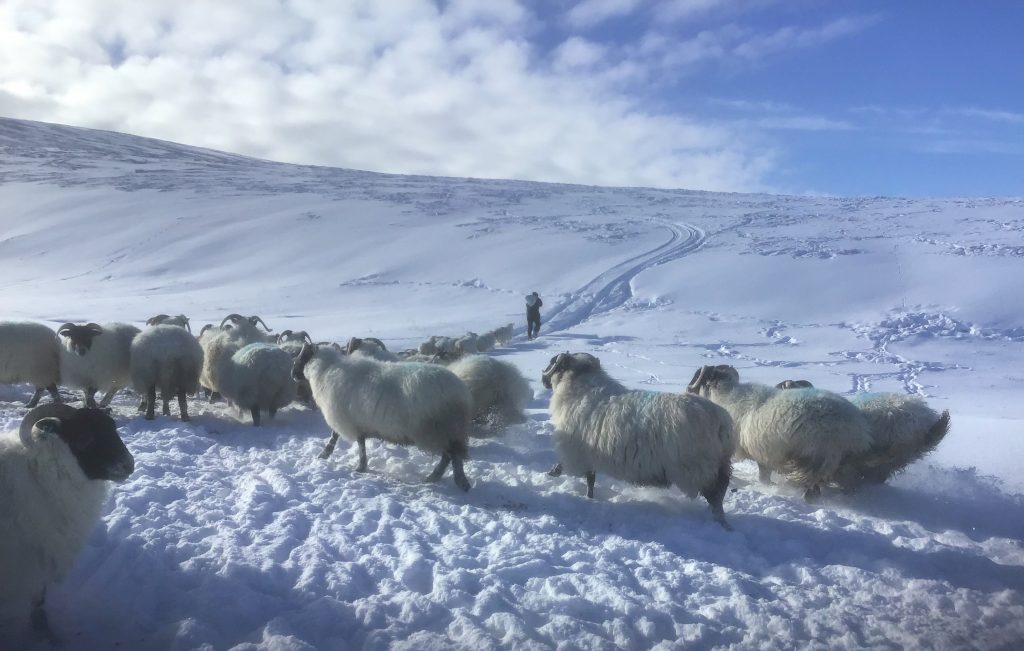
Before launching into the joys of spring hopefully to be lavished upon us before too long; taking up where we left off last month, another picture from the frozen north. I love this picture, it could almost be a painting. Here was our friend Tim, not all that long ago, leading his Blackface ewes off the mountain back to the farm for scanning, they have got used to being fed nuts while the grass is buried under snow, and so are happy to follow him. The ewes carrying twins will be kept on the better pastures on the lower ground from now on, whereas the ones with singles will be allowed to find their way back to the hill to which they are hefted. There has been more snow on these Northumbrian hills close to the Scottish border than for many years, it is a harsh environment, for man and beast. Our friends said that it was young farmers’ country when they first went there in the early 90s, they are still there, so they must still be young!
Here in the soft south we have made a good start to spring sowing, 25ha of beans went into a drying seedbed in the first week of March, followed by 70ha of barley at the beginning of this week, again into good seedbeds. Once the weather broke on Tuesday, we parked the machines to wait for the next weather window. We can’t sow much more until the animals have finished munching the turnips in the last two fields planned for barley. In the last few dry weeks, the animals have enjoyed remaining on the soil surface rather than wading around hock deep in mud, and have been able to enjoy a higher turnip to soil diet ratio than when it’s wetter.
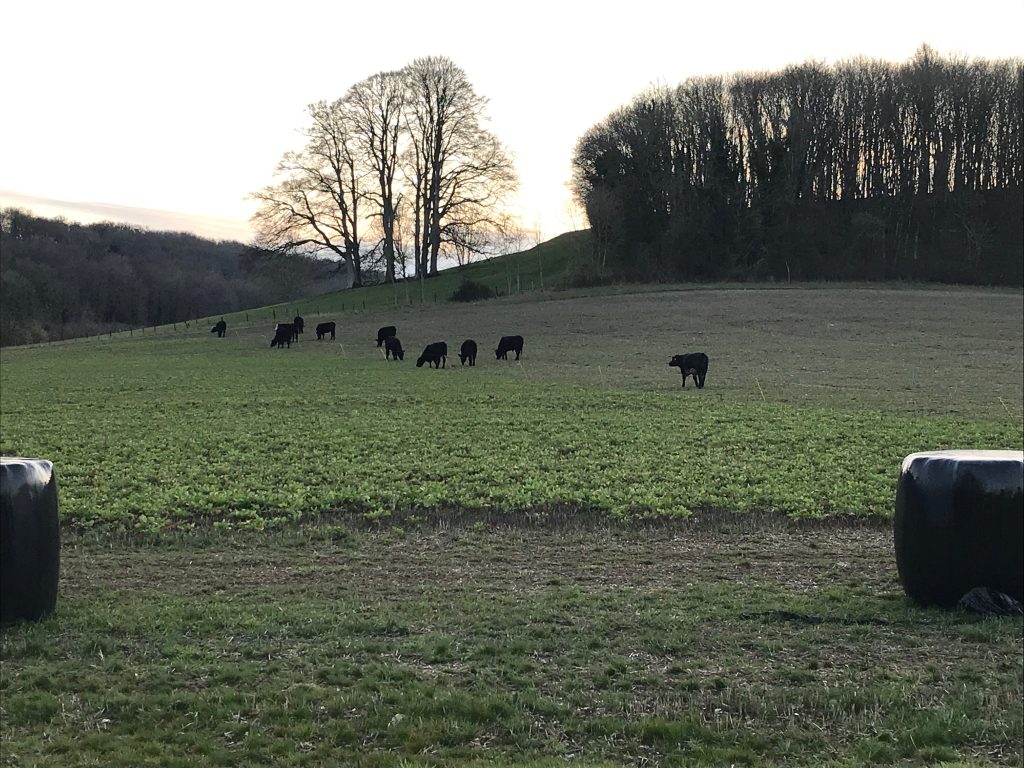
It is always a challenge getting the stock off the arable fields so we can get the spring crops sown in good time, but the grass hasn’t started growing yet so we have to hold the animals on the arable land for a bit longer, hoping there’s enough grub to last them until it does. Here the older cattle are eking out the turnips in the Park at 7 metres per day, plus all-you-can-eat silage. Once the grub has run out and we have moved the animals back up the farm, we will need to call up Will Mogridge to spread the digestate heaped up in the field, then Gary will be along with a cultivator to loosen up the cattle-trampled soil before we sow the barley.
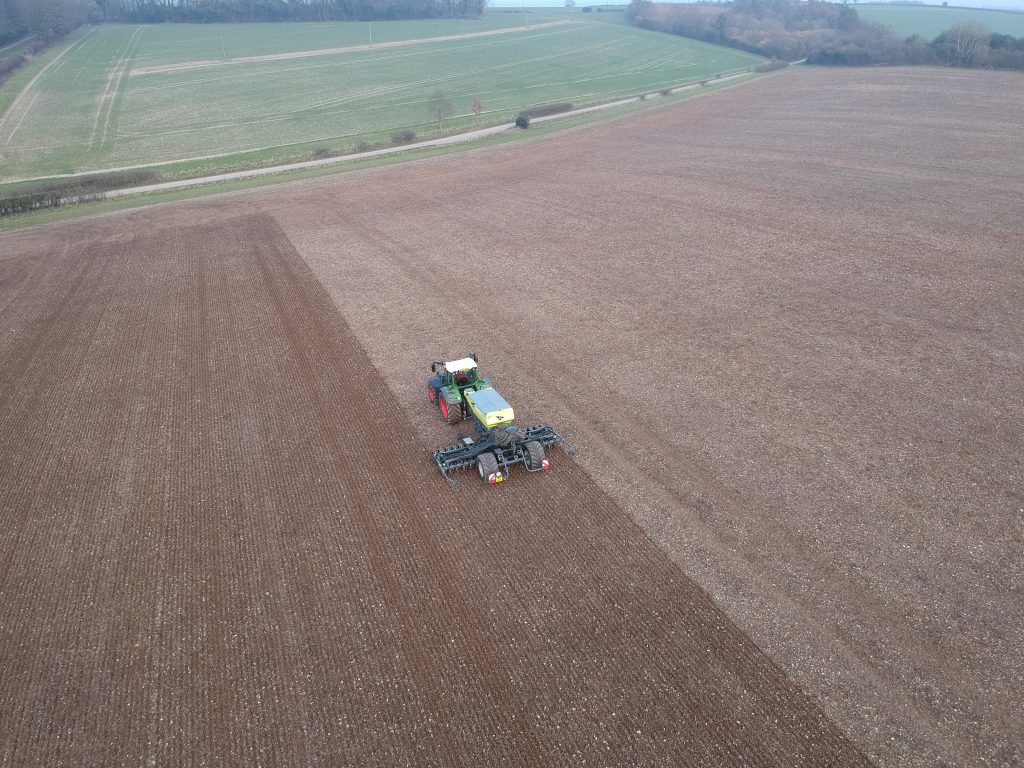
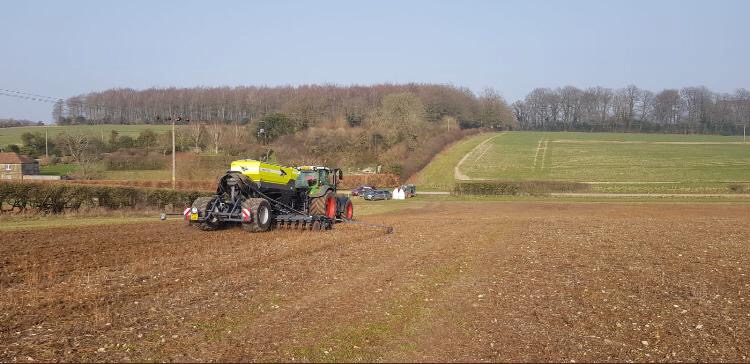
The pictures above show a Sky drill at work, sadly not our own. Regular readers may recall that we ordered a new drill last autumn, with delivery promised in time for spring sowing. The new machine is still in France, but to give credit to Opico, the importer, and C&O Tractors our local dealer, they were able to supply their demonstrator drill for a day of bean drilling, so we will be able to see how no-till beans fare against a Knight M-press cultivation in front of the old faithful Vaderstad rapid drill.
Indoors we are three quarters of the way through calving our 55 sucklers, two sets of twins to date is good news, although one of the cows decided she liked one calf but not the other. As if being a freemartin isn’t hard enough to cope with, having to be a rear-end drinker really is the pits. (A freemartin is a female calf whose twin is a male, the proximity to male hormones in the uterus renders the female sterile). An unloved calf is forced to drink from the rear so Mum can’t see it or push it away, and this of course is also where the cowpats land.
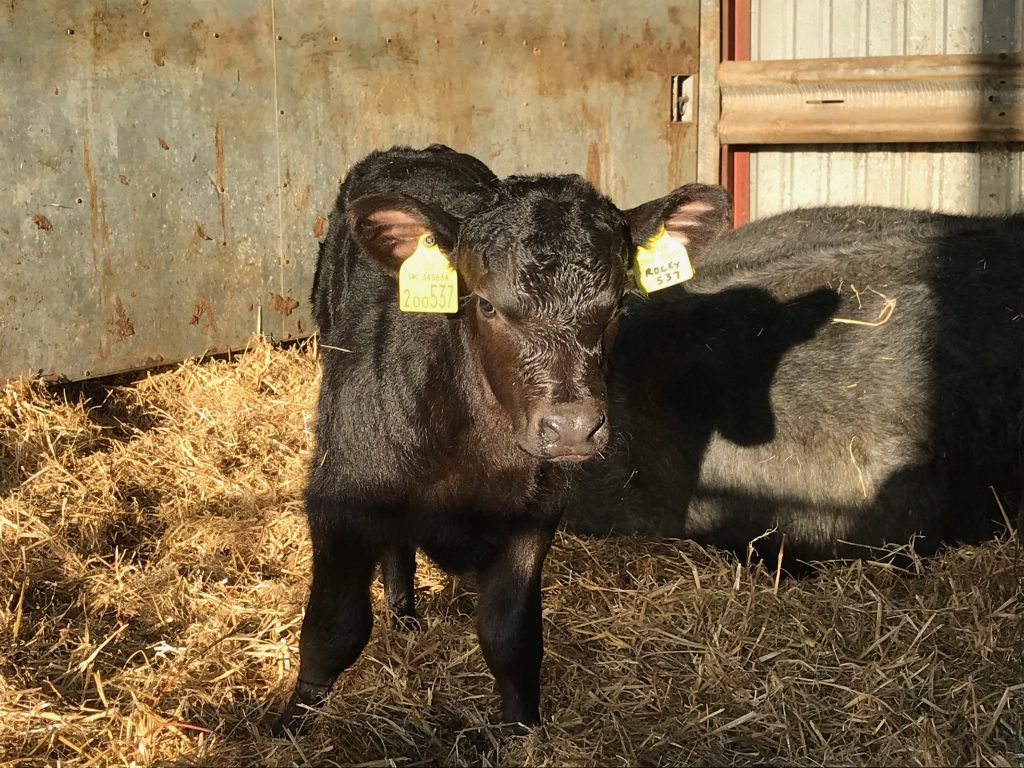
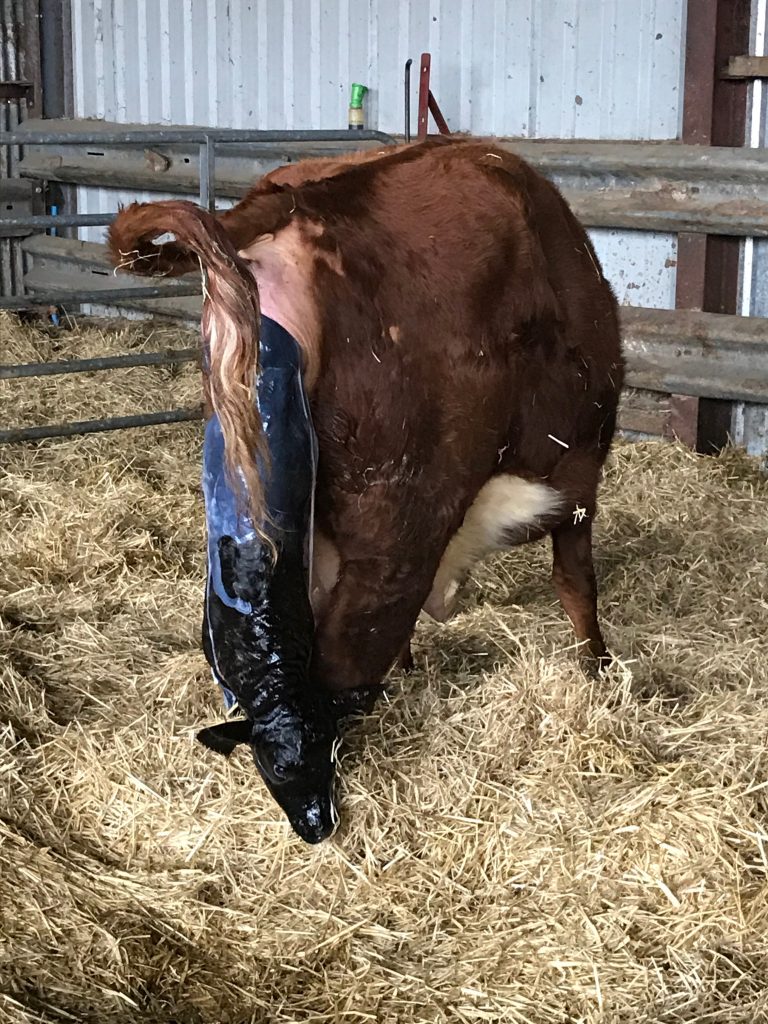
Ginge had been hard at it for a while, then got up before she had quite finished the job. The poor calf suddenly found itself in a tangled heap on the floor once gravity finally took over
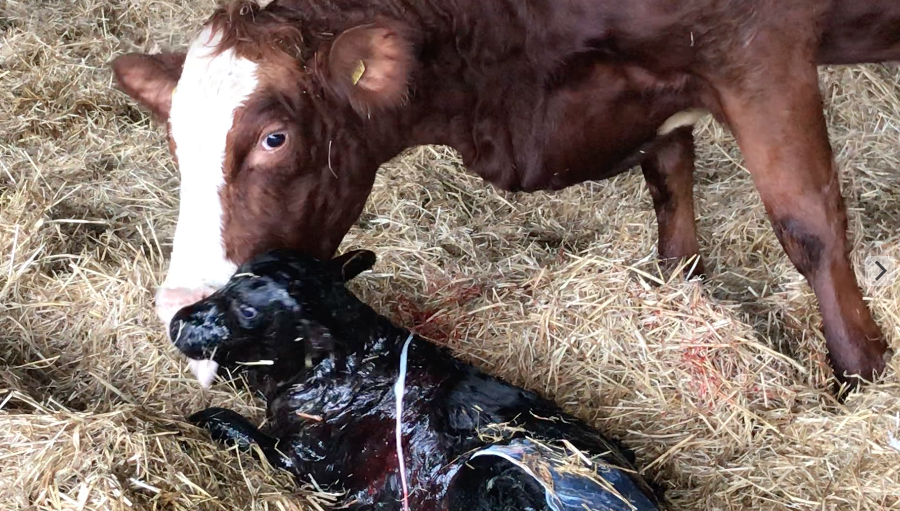
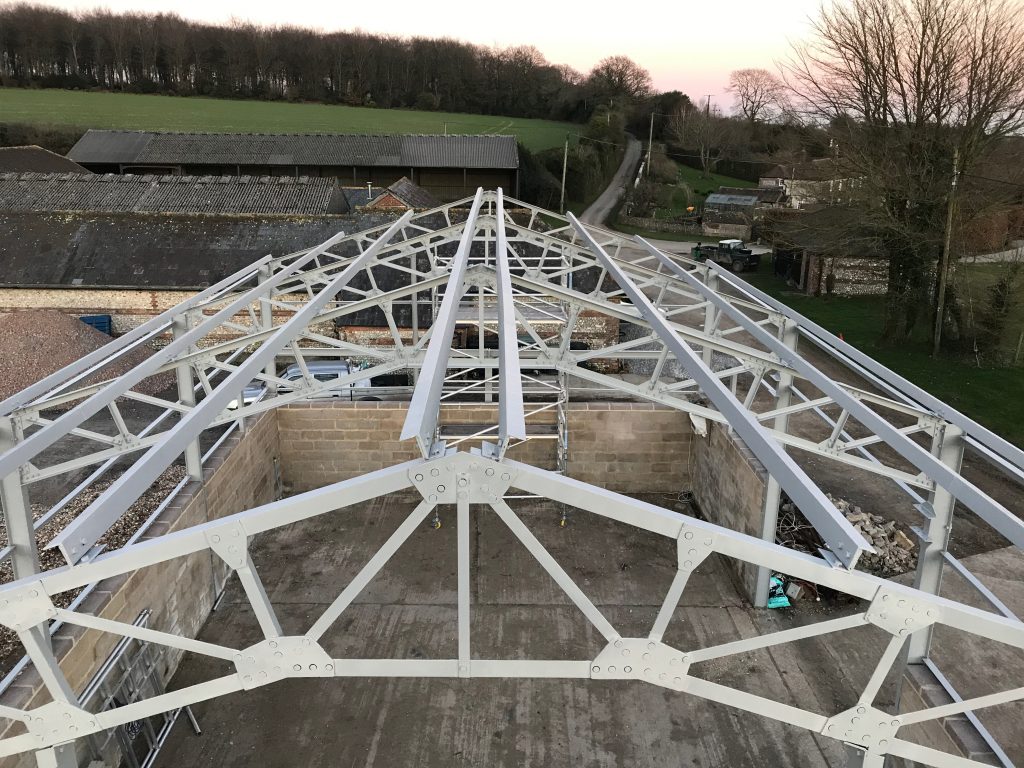
We have had a steep learning curve dealing with our steel-framed barn renovation project, shot blasting is all very well in theory. After hiring the blasting kit from Lancashire, and borrowing a compressor from a generous local friend, we thought we were sorted. We didn’t bank on a week of sporadic rain, which didn’t stop the blasting itself, but it meant we couldn’t paint the steel after cleaning, so no blasting. The rain was followed by that seriously cold snap, when we discovered that condensation you get in the pipes freezes up, so still no blasting, and more hire time wasted. Eventually we finished the blasting, and got the first layer of red oxide paint safely applied. On we went with the top coat, but again we got caught out by sudden unexpected showers which washed off an afternoon’s paint overnight. A return to frosty nights taught us further the perils of using a water based top coat, anything applied late afternoon, or in the dark, had no time to dry, and seemed to freeze off, needing re-painting on a warmer day. “Why would you do a job like this in February you idiots?” It’s a fair question, but once the weather warms up there’s proper work top get on with, and our new tenants are itching to take possession, so needs must. We’re getting there.
Below is the cherry picker we have hired to help with the shot blasting, one day it had to have its 6 monthly safety check, so had to reach for the sky to show all worked correctly.
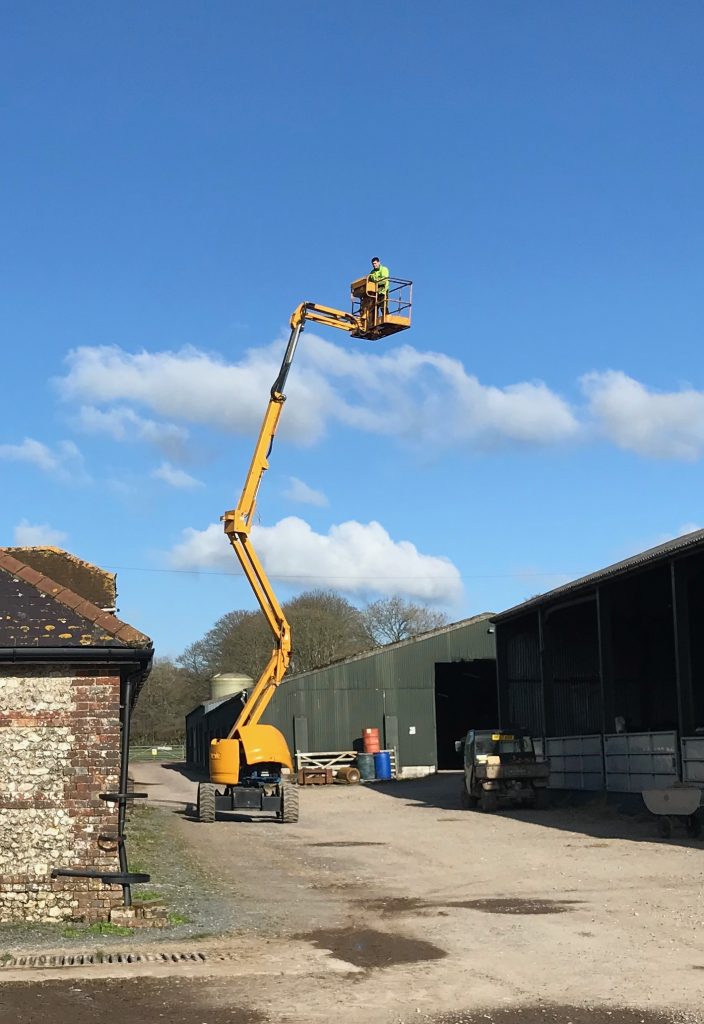
More wildlife from Alan Wickes’ camera: Hare, roe deer, stonechat:
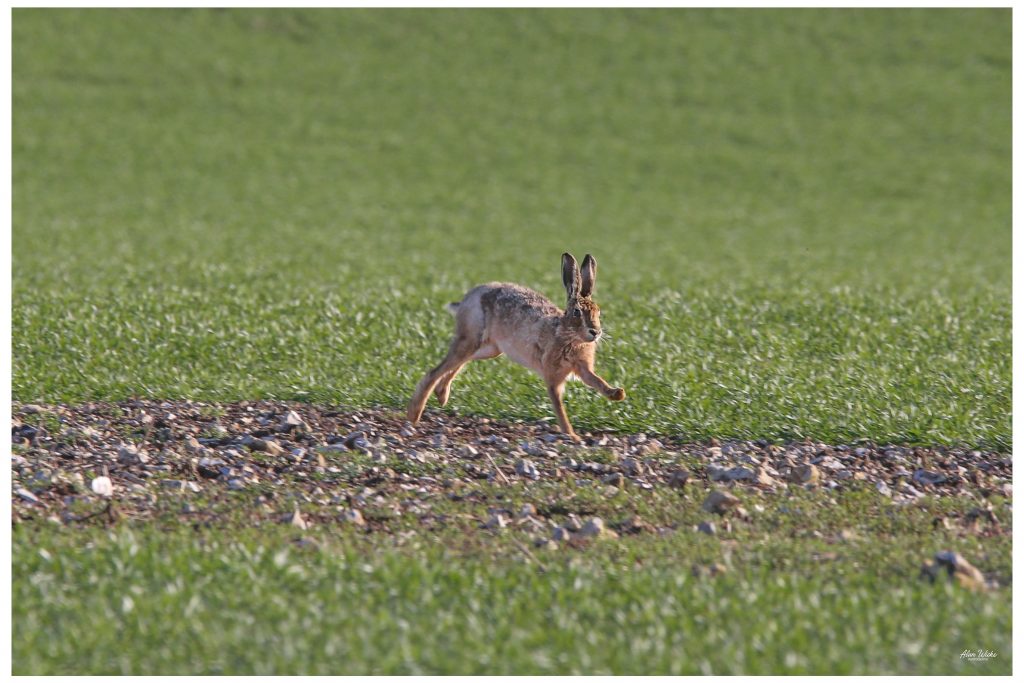
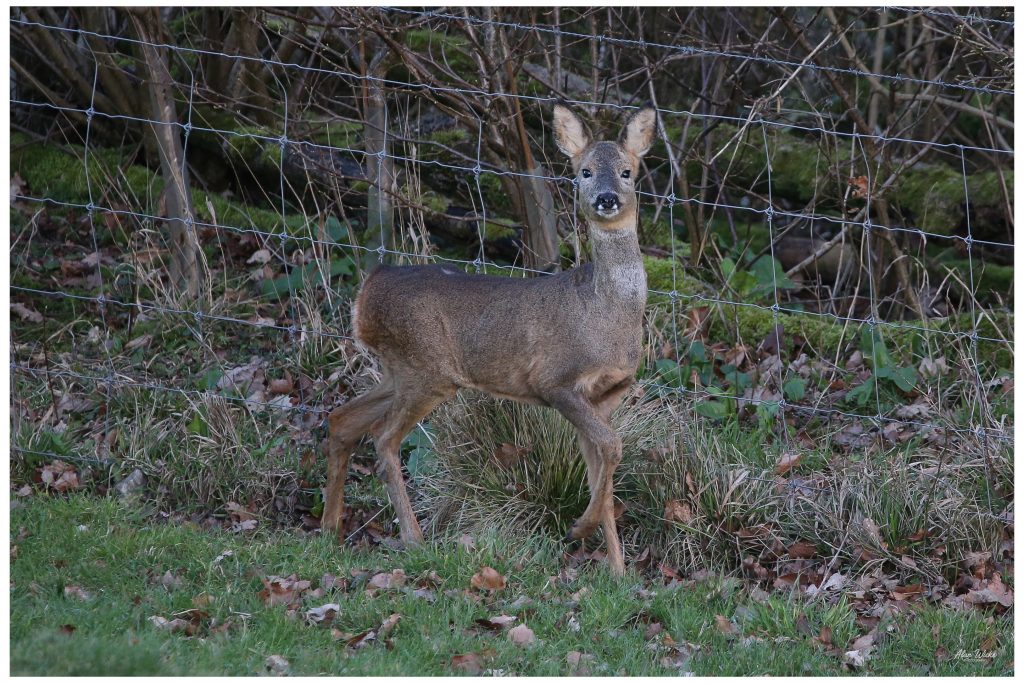
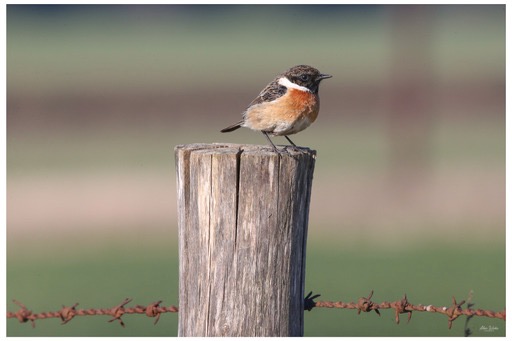
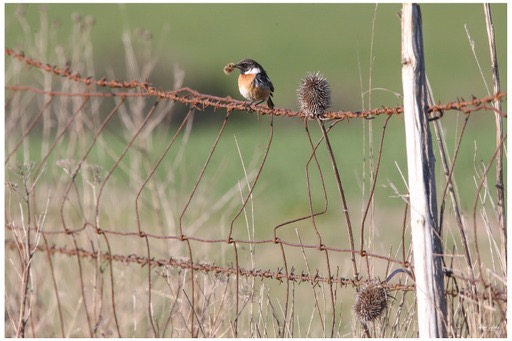
And from my own, early morning misty sunrise at the yard:
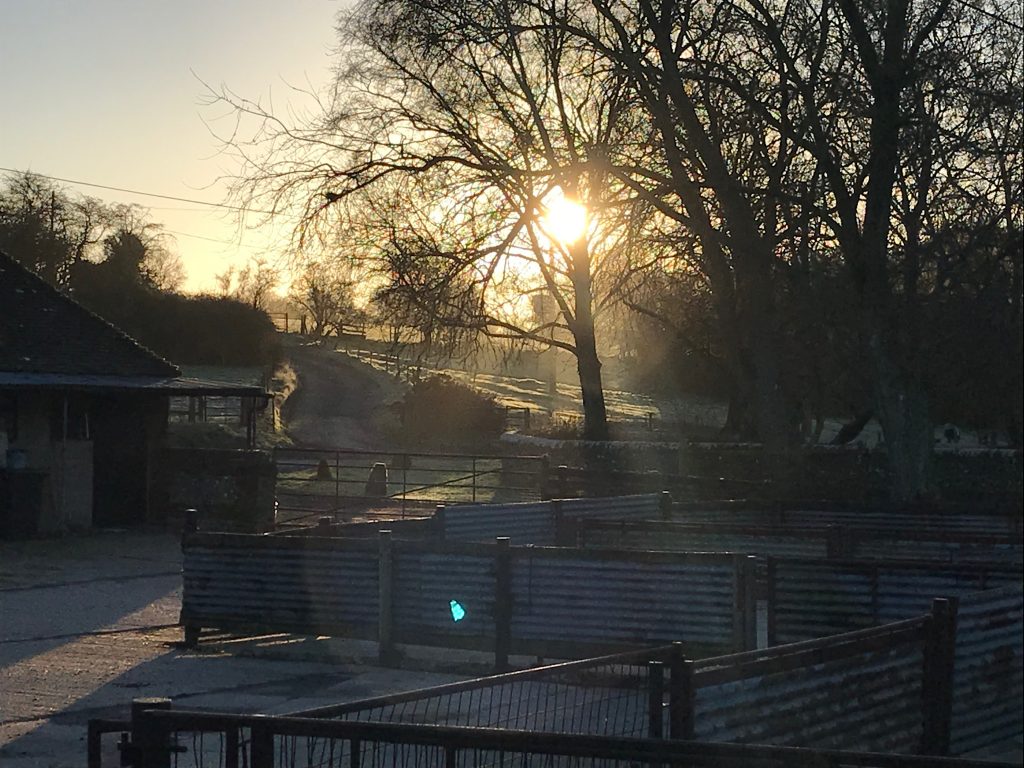
A fascinating webinar delivered by Dr Christine Jones, in February, from her home in Australia, sponsored by Oakbank seeds and Sky Agriculture, was attended by over 350 people keen to improve their soils. The strongest of many messages I took away from this talk relates to pasture management, and how to use pasture and animals to improve soils. The slide below explains what mob grazing is supposed to do and why it is potentially so valuable. The tighter the animals graze plants, whether grass or herbs, the more the root mass is reduced, and hence the good the roots can do for the soil reduces too. Farmers have traditionally allowed their animals to graze until the grass is mostly gone, before moving them to the next paddock, believing this to be the most efficient way to operate. However research is showing that this is not necessarily the best way. The plant needs green leaf area to harvest sunlight, and to turn it into more leaf area and root material, so we need to leave enough of it behind to do this, and move the animals on to the next paddock more quickly. This is going to be quite difficult to put into practice, because to start with it will feel like we are wasting grass. After a whole cycle however, say 40 days in a paddock system of 10 paddocks with 4 days in each paddock, the animals will come back into the first grazed paddock where it will have grown that much more than it would have done had it been grazed to the ground. Some advocates of this system suggest you should only graze each paddock for one day. However it depends also how big one’s mob of cattle is. A large number for a short time is supposedly better than a smaller number for a longer time. We will have to find a balance that works.
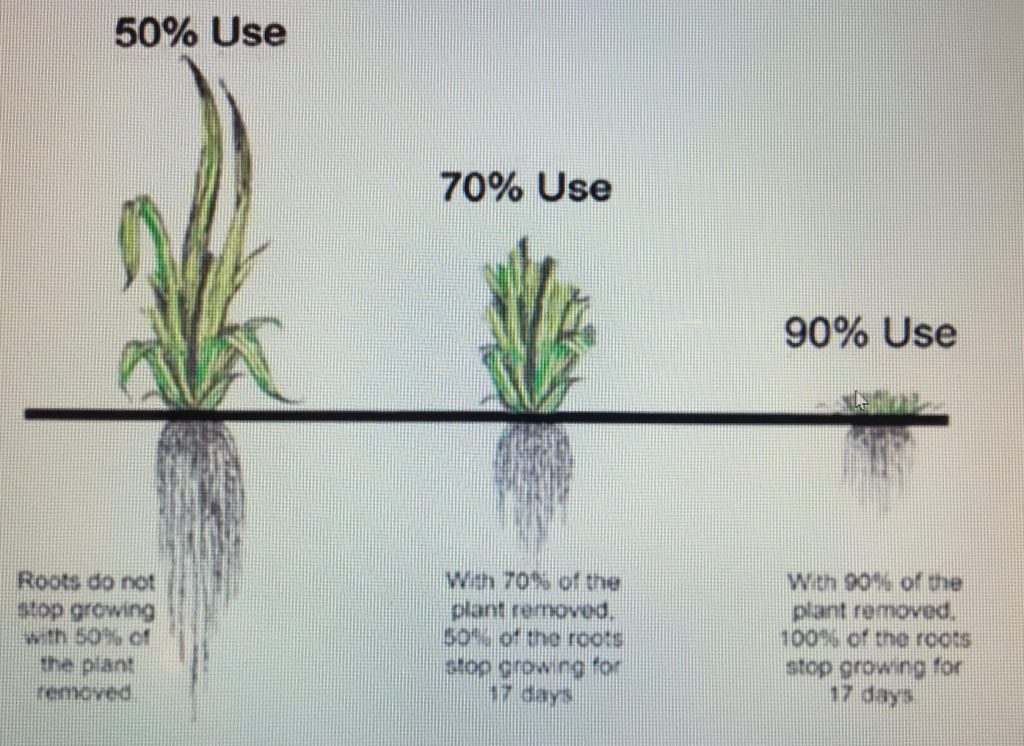
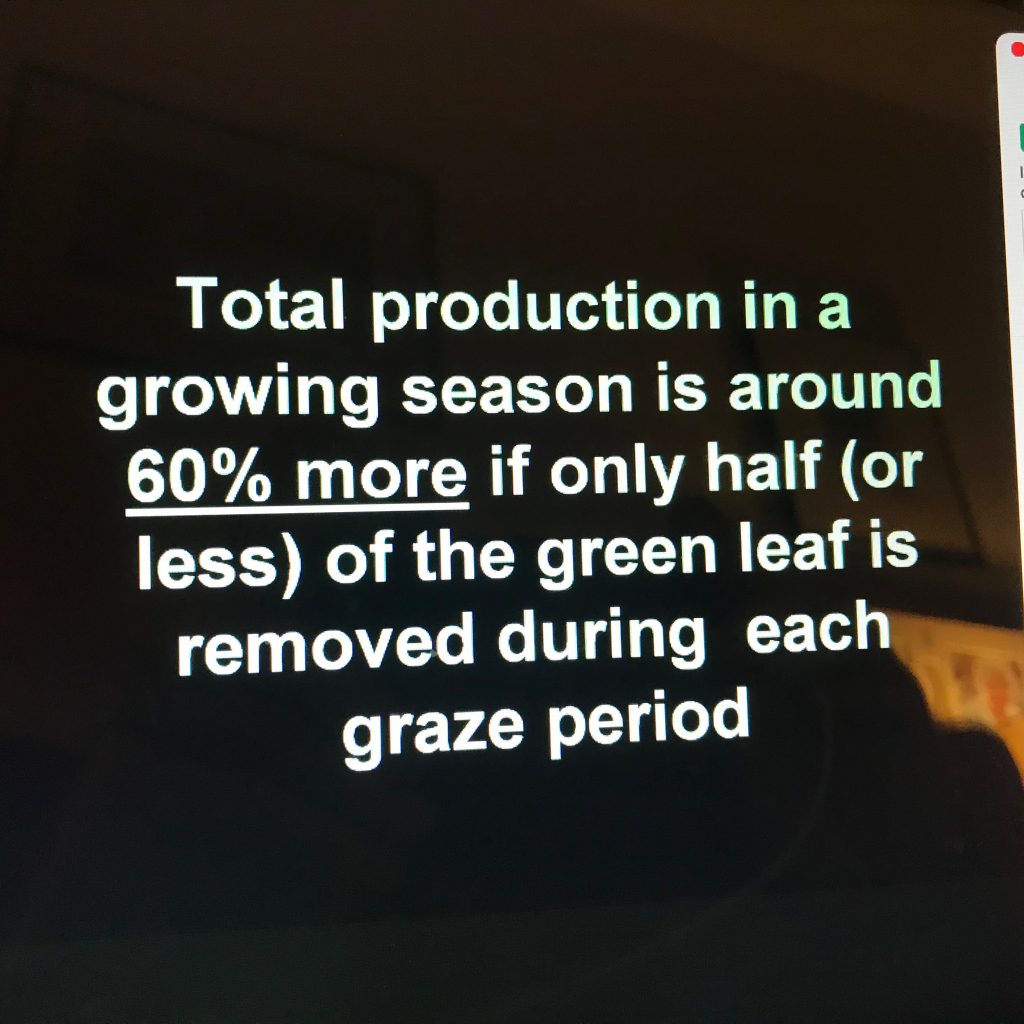
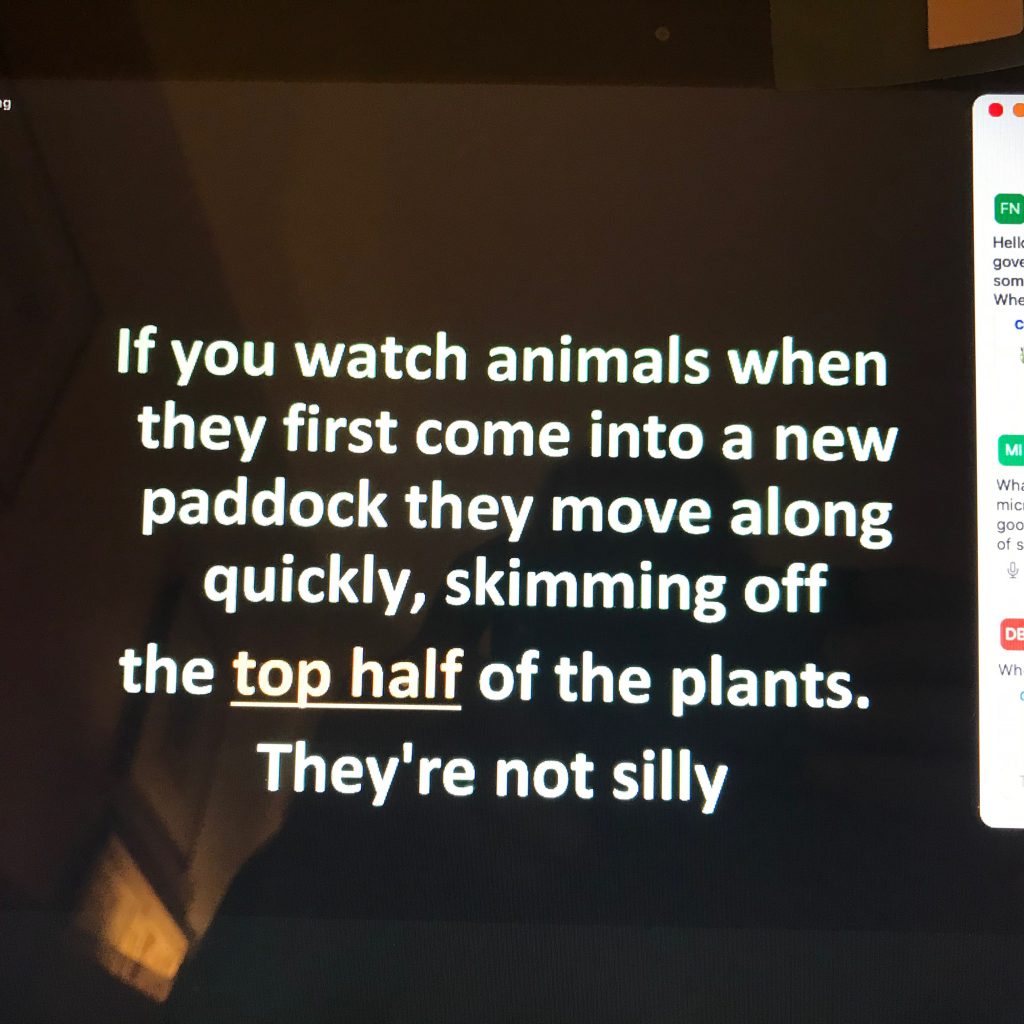
Those are the lines that will appeal first, the following is the most serious point of the whole business:
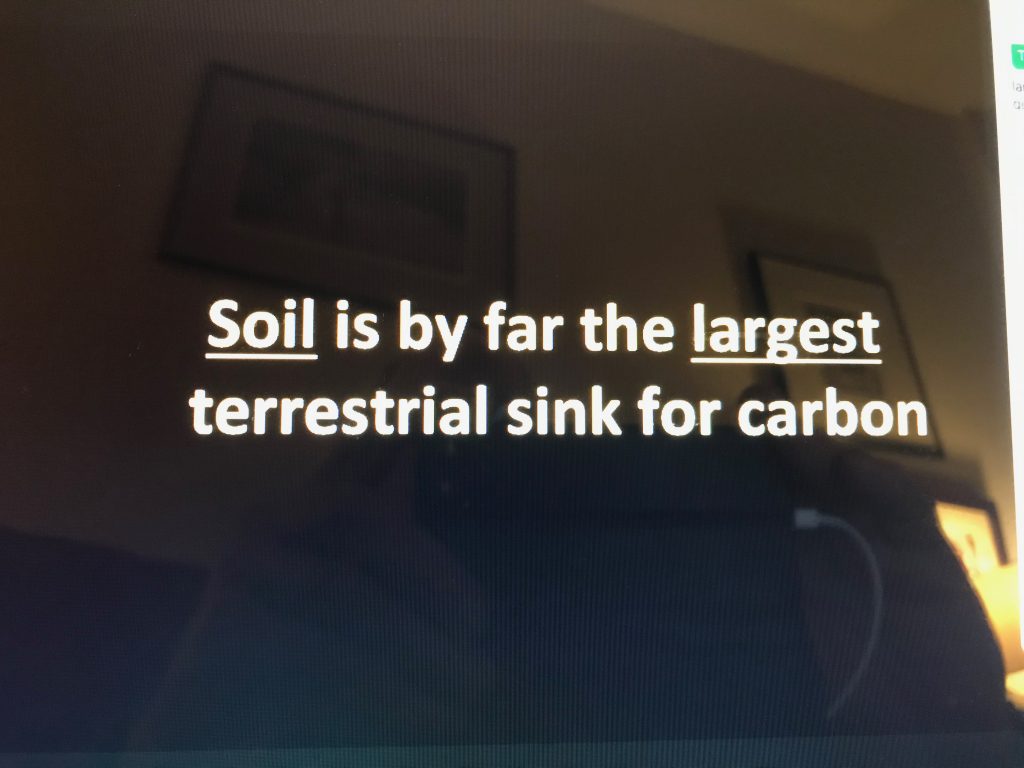
Allowing the root mass of plants to grow larger in the soil is one of the most effective ways to sequestrate carbon from the atmosphere. Plants take CO2 from the air, and along with water and sunshine, using the chlorophyll in their leaves, they create sugars, some of which are used to grow more plant, and some are pumped through the roots into the soil, to build relationships with fungi in the soil who in turn source nutrients and minerals from the soil, and supply them to the plant. A healthy soil contains a whole ecosystem of larger and smaller organisms, and when working well and not too degraded by excessive cultivations and artificial fertilisers, can support healthier and more productive crops.
Larger root mass and enhanced biological activity in the soil creates a virtual cycle of improvement, so if one can achieve this by farming pasture and livestock for a year or two, one should then be able to grow a year or two of arable crops with fewer inputs. It has been shown that fertility building in this way is far quicker when there are livestock in the rotation, so that far from having a bad effect on climate change, good rotational farming with livestock in the system can sequestrate carbon more quickly than ending livestock farming and trying to do it all with crops alone.
If you are interested in following up Dr Jones’ whole talk, it is here:
REGENERATIVE AGRICULTURE IS BASED ON 5 CORE PRINCIPLES:
- 1. Keep the soil surface covered as much as possible
- 2. Try to limit the amount of physical and chemical disturbance of the soil as much as possible
- 3. A wide diversity of plants is encouraged to increase soil biodiversity
- 4. Keep living roots in the soil for as much of the year as possible
- 5. Integrate grazing livestock into the system


If you want tips on mob grazing just ask Ruth Archer of Brookfields Farm Ambridge she’s always rattling on about it.
Thanks George, another excellent read. I learn a lot and have been examining our own short grass farming system for a while with regard to declining productivity…so some lessening of stocking rates may come to higher profitability.
It is tempting to try the ‘leave a loat of grass behind in the field’ method but I simply don’t have enough acres to spread the animals around that much. I conserve the longer grass into hay or silage for the next winter or dry periods in the summer.
If I ‘mob grazed’ by putting a very high stocking rate of cattle (almost touching) on a small peice of ground and moved the cattle once or twice a day then I would spend half my life moving fences and water troughs etc. There is not enough money in the job to spend half the day, every day in the summer moving cattle.
I know that putting a whole bunch of animals in a field and leaving them for a few weeks may not be so efficient but one has to realise that there are opportunity costs to the advocated methods above.
Dear George,
I think I have a clearer idea of regenerative agriculture , but not a clue as to how much work it involves when you look at the amount of stock movement that is part and parcel of such a scheme.
As for new words…
freemartin is one that I shall have to really think about when I slip it into a sentence!!!!! Here’s hoping that the “Sky “ isn’t the limit but that it arrives soon!
Thanks 🙏 again for a great report
Rogxxxxx
As ever, George, you put into words very eloquently what I am thinking with regard to soils and modern agriculture. Furthermore you are doing something about it. I applaud you and your brother and hope to follow you with these practices on my farm.